Alyssa Koehler, Extension Field Crops Pathologist; akoehler@udel.edu
I have been seeing the first tassels in corn over the past few days. As tasseling begins, it is a good time to scout fields to decide if a fungicide will be applied. When considering the economics of a fungicide application, it is important to know your potential for disease based on field history, environmental conditions, and hybrid selection. Many of the foliar pathogens of corn can survive in residue, so corn-on-corn fields carry a higher potential for disease, especially if disease has been observed in previous years. Hybrids with good resistance ratings may keep disease levels low enough that the addition of a fungicide is not needed. Resistant hybrids typically have smaller lesions and reduced spread of spores. In dryland fields, hot, dry weather will also keep disease pressure low. Irrigated fields create a favorable environment for disease by maintaining moisture and higher relative humidity in the canopy. Rain amounts have been variable across the region, and to date reports of foliar diseases have been minimal. The humidity of the past week may get some diseases started for the year. While you are out scouting, here are some tips for sorting out diseases:
Grey leaf spot (GLS) is our most common foliar disease of corn. Symptoms usually begin on lower leaves as small, tan, rectangular lesions with a yellow halo. When lesions are young, they can be difficult to distinguish from other common corn foliar diseases. As lesions mature, they become more diagnostic. At maturity, lesions are grey to tan in color, with a long rectangular shape (Figure 1); partially resistant hybrids can have more jagged margins than lesions on susceptible cultivars. Lesions often join to form large necrotic areas under favorable environmental conditions. Yield reductions are typically observed when lesions are present on the two leaves below the ear leaf or higher, so these are the leaves to pay close attention to when scouting. If over 50% of plants have lesions on 5% or more of this leaf surface (ear leaf or 2 below), you may want to consider a fungicide application. If applying a fungicide, VT/R1 timing has shown the greatest chance of economic return for GLS. The 2023 Fungicide Efficacy for Control of Corn Diseases, provides ratings of product performance across multiple diseases based on trials conducted by Extension specialists across the country.

Figure 1. Rectangular lesions of Grey Leaf Spot on Corn (Photo: A. Koehler)
Curvularia leaf spot is a relatively new disease that was first observed in the region at the end of 2020. Lesions will have a brown border with a yellow halo that can look very similar to the start of a GLS lesion. However, these lesions will usually stay small and round, while GLS lesions will continue to expand to a rectangular shape (Figure 2). Lesions can be scattered or in dense groups. At present, this disease is not associated with notable yield loss and foliar fungicides are not labeled for management of Curvularia leaf spot.
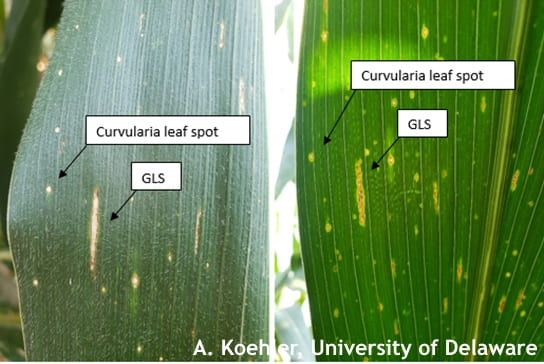
Figure 2. Curvularia leaf spot v. GLS on the upper (left) and lower (right) corn leaf (Photo: A. Koehler)
Northern Corn Leaf Blight (NCLB) is present in the regions at low levels, often showing up later in the season. Like many of the foliar diseases, the fungal pathogen causing this disease is favored by prolonged wet weather and canopy moisture. These lesions will be oblong to cigar shape (Figure 3).
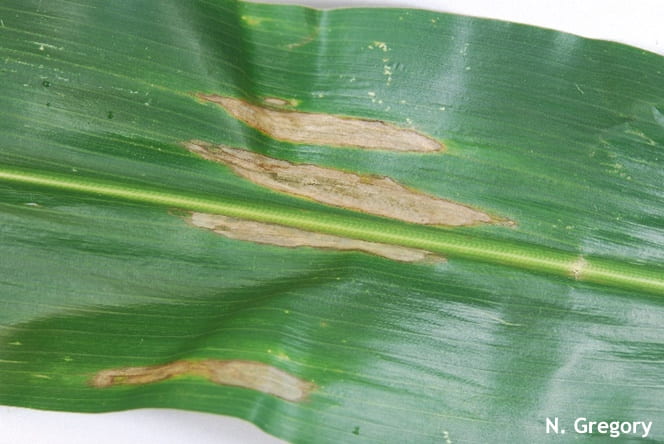
Figure 3. Northern Corn Leaf Blight lesions
Diplodia leaf streak can be observed occasionally in the region, most often in fields with corn on corn rotation. These lesions can look similar to NCLB, but inside of the lesions you will see black dots called pycnidia that contain spores of this fungus (Figure 4).
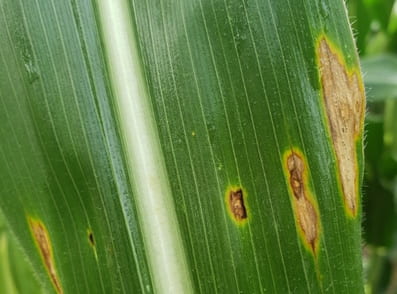
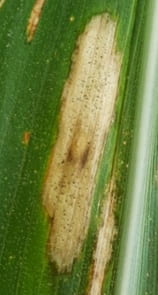
Figure 4. Symptoms of Diplodia leaf streak (left), close up of a lesion with black pycnidia (center)
As you are out scouting, you will also want to monitor for Tar Spot, a foliar disease caused by the fungus Phyllachora maydis. It first showed up in northern Illinois and Indiana in 2015 and was found in Lancaster County at the end of the 2020 season. During the 2021 and 2022 seasons it has continued to spread to surrounding PA counties and was first confirmed in MD in 2022. To date, this disease has not been reported in DE. The fungus produces small, raised, black bumpy lesions that look like specks of tar, giving it the common name of tar spot (Figure 5). These structures known as stroma can be on the upper or lower leaf surface and do not wipe off the corn leaf. In severe cases, lesions may also be observed on the leaf sheaths, husks, and tassels. Tar spot is most often observed after silking, but can appear earlier, particularly in areas where it is established. If you suspect you have Tar Spot, please contact your county extension agent or submit a sample to the UD plant diagnostic lab for confirmation.
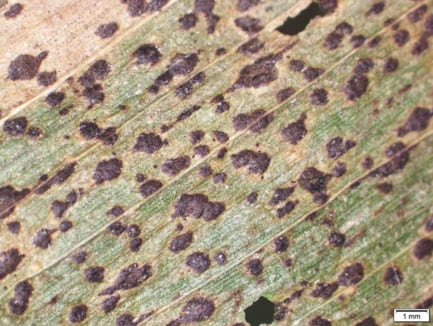
Figure 5. Slightly raised, black stroma of Phyllachora maydis (https://cropprotectionnetwork.org/publications/an-overview-of-tar-spot)
